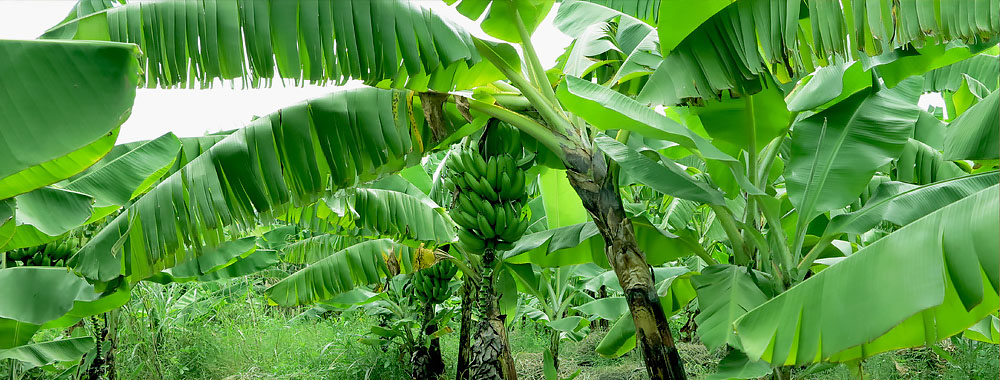
The Chagga – The Tribe of the Kilimanjaro
At the foot of Mount Kilimanjaro, outside the entrance to Kilimanjaro National Park, lie the beautiful towns of Mamba and Marangu. Here, local people of the Wachagga tribe have planned walking tours through valleys and waterfalls depicting mountain village life. We will be more than happy to arrange a custom made tour to satisfy your preference if you wish to focus on certain aspects.
Now numbering over a million, the Chagga occupy the southern and eastern slopes of the Kilimanjaro and are among East Africa's wealthiest and most highly educated people. Their wealth, and that of Moshi, stems from the fortunate conjunction of favorable climatic conditions with their own agricultural ingenuity.
Coffee and bananas
Watered by year round snow and ice melt, the volcanic soils of Kilimanjaro's lower slopes are extremely fertile and are exploited by the Chagga using a sophisticated system of intensive irrigation methods and continuous fertilization with animal manure which permits year round cultivation and supports one of Tanzania's highest human population densities. Arabica coffee has been the Chagga's primary cash crop since colonial times, although maize and bananas remain staple foods. The cultivation of bananas is traditionally a man's work, as is that of eleusine seed (ulezi), which is boiled and mixed with mashed plantain to brew a local beer (umbege or mbega) that is still used in traditional ceremonies and as a form of payment to elders in their role as arbiters in conflicts.
400 Clans
In the past, the potential for such conflicts was great: even today there are some four hundred different Chagga clans – indeed it's barely a century since the Chagga finally coalesced into a distinct and unified tribe. Most are related to the Kamba of Kenya, who migrated northwards from Kilimanjaro a few centuries ago during a great drought. Other clans descend from the Taita, another Kenyan tribe, and others from the pastoral Maasai, whose influence is visible in the importance attached to cattle as bride wealth payments and in the grouping of men into age-sets analogous to the Maasai system.
Today, the Chagga wield considerable political and financial clout, both because of their long contact with European models of education and Christianity, both of which dominate modern-day political and economic life, and because of their involvement in the coffee business, which remains the region's economic mainstay in spite of volatile world prices. Indeed, the Chagga are the one tribe you're almost guaranteed to meet in even the most obscure corners of Tanzania, working as traders, merchants, officials, teachers and doctors.
Waterfalls
Magnificent views of valleys and waterfalls offer great entertainment for nature lovers and bird watchers. With more than seven waterfalls in the vicinity one can spend a whole day enjoying the picture postcard views. Walking tours will provide amazing views overlooking the area including points where the lights of Nairobi can be seen at night. Walking through the well maintained coffee and banana fields is a pleasure. Visits to tree, flower and fruit nurseries help to portray mountain life and give guests the chance to see a wide range of unique flora and fauna.
A morning visit to the ancient sites in the Makundi area recalls clan wars and historic legends. You can enter the Laka Holes, large hiding caves which were used to protect women and children during the Maasai-Chagga Wars. Visitors will actually get to see blacksmiths who still use traditional methods to prepare spears and tools used by Maasai people today! A local woodcarving school allows visitors to meet a skilled teacher who is one of the oldest active members within the community.
Marangu
Mountain climbing enthusiasts will be delighted to visit the home and memorial of the late Yohano Lauwo, a Marangu native who accompanied Dr. Hans Meyer on the first recorded climb of Kilimanjaro in 1889. He lived for an astonishing 124 years and guided treks up the mountain at the edge of 70 years! Walking tours through Marangu also offer breathtaking scenery. You can visit Kinukamori, Moonjo or Mteshane waterfall depending on your physical condition.
You can learn more about the Chagga culture by visiting a traditional Chagga house with straw roof. You can walk through the Chief Mangi area where the first court and primary school of the Northern region are still functioning. At the Kilema Roman catholic mission, you can see the first coffee tree planted in Tanzania by an Irish missionary 100 years ago. Kilimanjaro area is now one of the leading coffee producers in the country. A light climb up Ngangu hill with its fantastic view is a pleasure. On clear days the snow of Kibo Peak is so close, the plains so wide and the Pare Mountains to grab.